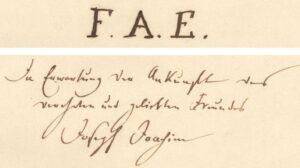 Our new Urtext edition HN 1572 introduced in today’s blog post is, in many respects, something very special. Starting with the title: Never before has a Henle score named three composers on the cover – Albert Dietrich, Robert Schumann and Johannes Brahms. But since it is well known that a book is not to be judged by its cover, we want to take a closer look at the contents to shed some light on the genesis of this unusual joint composition, the F.A.E. Sonata for violin and piano.
Our new Urtext edition HN 1572 introduced in today’s blog post is, in many respects, something very special. Starting with the title: Never before has a Henle score named three composers on the cover – Albert Dietrich, Robert Schumann and Johannes Brahms. But since it is well known that a book is not to be judged by its cover, we want to take a closer look at the contents to shed some light on the genesis of this unusual joint composition, the F.A.E. Sonata for violin and piano.
No better expert for this is to be found than the editor of this new edition, Dr Michael Struck, up to 2018 a full-time staff member of the Kiel Johannes Brahms Complete Edition, and since then an honorary volunteer scholar. As Dr Struck also has excellent expertise in the Robert Schumann oeuvre, I had the following interview with him.
Dominik Rahmer (DR): Dear Dr Struck, can you briefly outline how this unusual ‘triple-composition’ project came about in 1853 and whose idea it was?
Michael Struck (MS): The idea originated with Robert Schumann in mid-October 1853 – shortly after he first became acquainted with the 20-year-old Johannes Brahms. Schumann, together with the 24-year-old Albert Dietrich who had immediately made friends with Brahms, wanted to compose a violin sonata for their mutual artist friend Joseph Joachim, regarded not only as a famous violinist already at age 22, but also as a promising composer. Over the course of 1853, a deep friendship had developed between Joachim and Brahms as well as also between Joachim and the Schumann couple. Several times between the end of August and mid-October, Joachim had been the Schumanns’ house guest and was just now awaited for his participation in two concerts at the end of October.
DR: Was then this idea of a collaborative composition completely new?

Albert Dietrich (1829–1908). Photography by Heinrich Daseking, ca. 1890
MS: No, with his plan Schumann was taking up an old concept. As early as 1837, in a letter to Ignaz Moscheles, he had devised the idea of collaborating with composer friends in a cycle of small compositions. And in 1841, he had published, together with his newlywed wife Clara Schumann, ‘Twelve Poems from Friedrich Rückert’s Liebesfrühling’; expressly not stated in this printed edition was who had contributed which lieder. In any event, joint compositions can occasionally be found in the first decades of the 19th century. Just think of Anton Diabelli’s having invited prominent Viennese composers to each write a variation on a waltz he had composed (the collection was published in 1824). And in 1839, Franz Liszt, together with his fellow virtuosi Sigismund Thalberg, Johann Peter Pixis, Henri Herz, Carl Czerny and Frédéric Chopin, published the variation work Hexaméron on an opera march by Vincenzo Bellini.
Getting together with Brahms and Dietrich in addition to developing his Joachim friendship thus encouraged Schumann once again to realise his old idea. Indeed, it seems as if in the fall of 1853 he was reviving the legendary ‘Davidsbund [Band of David]’ that in the 1830s had played such an important role in his contributions to the Neue Zeitschrift für Musik. This supposition also makes sense, Schumann was just then preparing to publish his Gesammelte Schriften über Musik und Musiker (Collected Writings on Music and Musicians) based on his old music essays and reviews from the 1830s to early 1840s.
DR: Reference is made in the sonata to Joseph Joachim’s private motto ‘Frei Aber Einsam [Free, but lonely]’ by embedding the tone sequence f-a-e. The three composers’ autograph manuscript bears the dedication title: ‘F. A. E. Robert Schumann, Albert Dietrich and Johs Brahms wrote this sonata in anticipation of the arrival of their revered and beloved friend Joseph Joachim.’ Is then this motif to be found in all the sonata movements, and are other musical allusions hidden in the work?
MS: The tone sequence f-a-e is unmistakable in its original and transposed form in the Dietrich first movement and in the two Schumann movements (Intermezzo and Finale). The f-a-e sequence is particularly frequent in the intermezzo lasting only 45 bars [see illustration].

‘F-A-E’ motif in movement II
At the finale’s opening Schumann also combined it with the g sharp-e-a tone sequence. In so doing, he captured, wittingly or unwittingly, the meaning of the Joachim life’s motto at the time: For Joachim was very amicably exchanging views with the young poetess Gisela von Arnim (Bettina von Arnim’s daughter) but was having to come to terms with the fact that Gisela was already in a relationship with the poet Herman Grimm, whom she later married. As recent Joachim research has more intensively shown, the violinist symbolised his freedom, bought through loneliness, in various works with the f-a-e tone sequence. Not known is how deeply Schumann and Dietrich were privy to Joachim’s emotional world when composing the F.A.E. sonata. Brahms is most likely to have known more precisely. But Schumann’s combination of the f-a-e tone sequence with g sharp-e-a (in German gis–e–a) as a cipher for ‘Gisela’ at his finale’s opening can at least be interpreted as a remarkable sign of his intuition [see illustration].
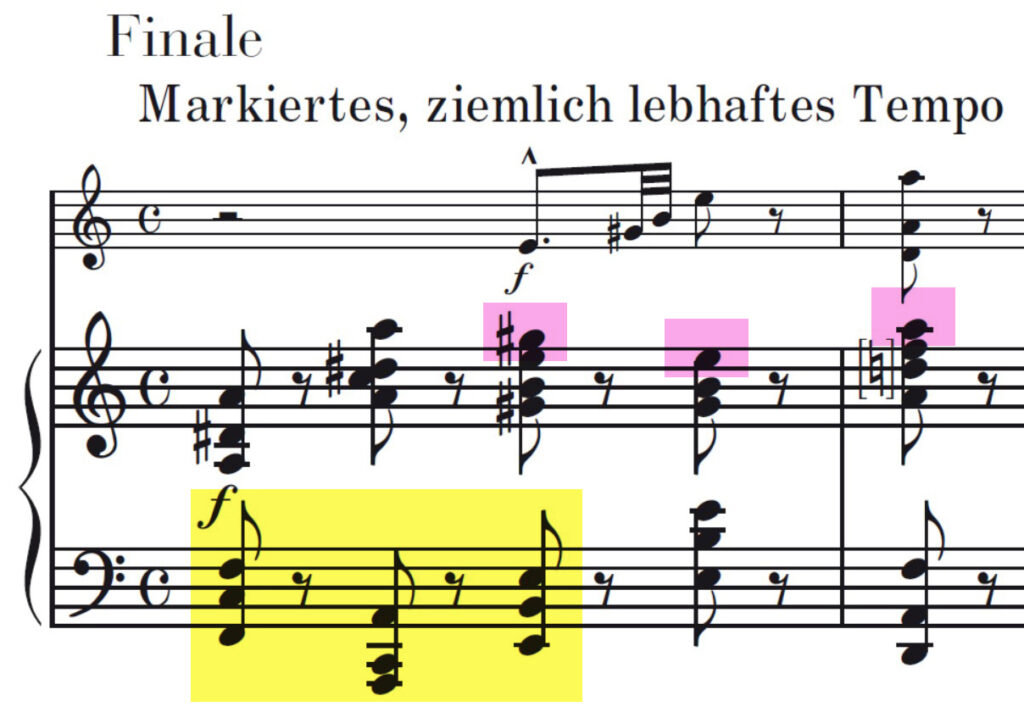
‘F-A-E’ motif (yellow) and ‘Gisela’ motif (pink) in movement IV
As is well known, Brahms did not stick to the f-a-e motto in his Allegro. Instead, he unmistakably took up Dietrich’s main theme in the secondary theme of his scherzo-like movement and transformed it. Was he humorously wanting to mislead Joachim, who was, after all, supposed to guess who wrote which movement the first time he played through the sonata dedicated to him? Schumann, on the other hand, made things easier for Joachim. Appearing at one point in the development section of the finale he composed is a theme from his ‘Fantasy’ for violin and orchestra op. 131, which Joachim had just premiered the day before the F.A.E. gift was presented to him.
Incidentally, I was able to discover in Brahms’s autograph of his movement that he altered the theme of the trio section by changing a few notes in three places. The original melody line was strongly reminiscent of themes from Schumann’s cello concerto and from the finale of his g-minor piano sonata [see illustration]. With this change Brahms probably wanted to neutralise this similarity.
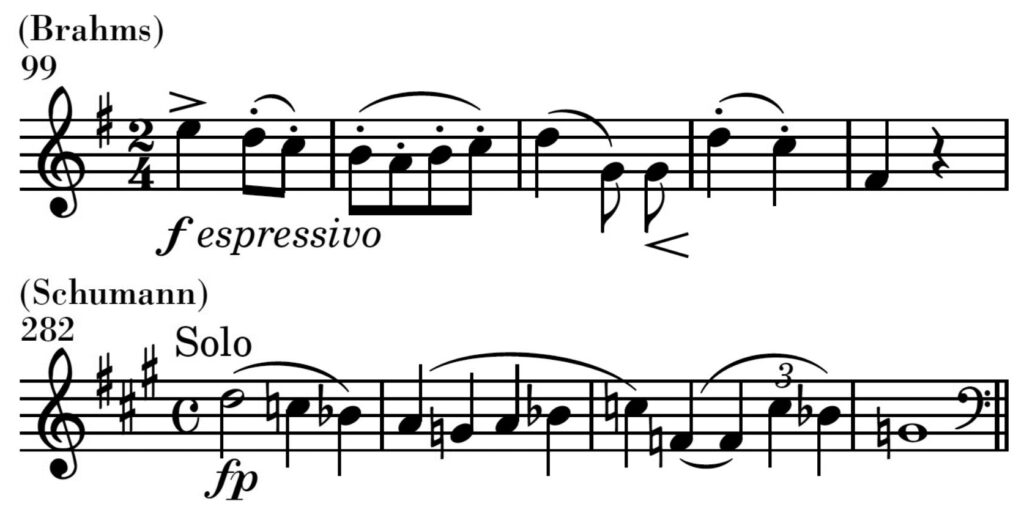
DR: The F.A.E. sonata did in fact remain unpublished during the lifetimes of everyone involved; its various printed editions appeared only in the 20th century, didn’t they?
MS: Yes, the sonata was first published in its entirety in 1935 – in a rather flawed edition slightly altered compositionally in several spots by the editors – and was reissued in 1953. Brahmsʼs scherzo movement had already appeared in print in 1906 (though not titled ‘Scherzo’) in an edition published by the German Brahms Society. Dietrich was the only one of the three composers still alive at that time. Further sonata editions followed in 1999, then in 2001 and 2006 (first in the violin-sonata volume of the new Schumann Complete Edition, then in a further revised performing edition) as well as in 2021 and 2023 (first in the violin-sonata volume of the new Brahms Complete Edition, then in the new Urtext edition derived from this).
No longer extant, unfortunately, is a manuscript of the sonata in its final form, pertaining at least to Schumann’s finale. Of the two clearly legible copyist’s copies used by Joachim and Clara for their first performance of the sonata, only the violin part has survived [see illustration], while the piano score was lost in the second half of the 20th century. To be seen in the extant copy of the violin part is that Schumann made numerous changes to the finale’s violin part. He must have entered the same changes into the full-score copy.

Violin part, copyist’s manuscript, page 1. Berlin, Staatsbibliothek , shelfmark Mus.ms.autogr. Schumann, R. 26
I rather doubt that the three composers ever thought of publishing their collaborative sonata – it was primarily a private work of friendship. Schumann did, after all, include his two F.A.E. movements in his 3rd violin sonata (WoO 2), composed shortly thereafter and, incidentally, first appearing in print in 1956.
DR: Unfortunately, as you just mentioned, an important source remains lost: the copy of the score used for the first private performance and then given to Joseph Joachim as a gift. What is known about its later fate, and can you tell us about your detective research regarding it?
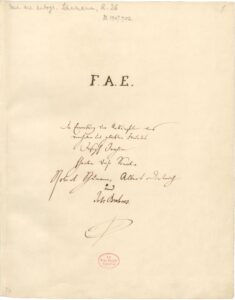
F.A.E. sonata, title page of the autograph score. Berlin, Staatsbibliothek, shelfmark Mus.ms.autogr. Schumann, R. 26
MS: First of all, let me slightly correct you: The full-score copy that after 1956 can alas no longer be traced, was indeed used for playing and initially presented to Joachim, together with the violin-part copy. However, the actual manuscript gift, was, of course, the work’s original inscription in the hands of his three friends [see illustration]. As I shall explain shortly, he was, though, unable to take it with him when he left Düsseldorf on October 30. Not until more than a week later did it come into his hands permanently and is now in his estate in the Berlin Staatsbibliothek. We know from an essay written in 1936 by the score copy’s former owner Heinrich Düsterbehn, that the copy was a first, provisional part of the humorously enigmatic sonata gift to Joachim. He was not supposed to recognise immediately from the handwriting who had composed which movement. According to Düsterbehn, the title of the score copy was: ‘Sonata for violin and pianoforte, dedicated to Joseph Joachim by an admirer’. The trick was that Joachim was apparently not even supposed to know at the start that several composers were involved in the sonata. The score copy was later in the possession of Albert Dietrich, who, around 1890, presented it to the young Oldenburg violinist Heinrich Düsterbehn with whom he had also played the sonata. Düsterbehn then bequeathed the score copy to his son Erich. But then it disappeared without a trace, and neither the research efforts of my Schumann colleague Ute Bär with the Düsterbehn descendants nor my own research efforts in the Oldenburg Theatre archives were successful. I did find information, though, in a book on the city Oldenburg’s music history, that the copy apparently still existed in 1956; that is, it had not been lost during the war. And by comparing the manuscript inscription with the violin-part copy and with Düsterbehn’s information about the score copy, I was able to reconstruct more precisely on what basis and in what way both copies were made by the copyist.
DR: You’ll have to explain that in more detail in a moment…. What is the general difference between your new edition and previous editions, and what new insights have you gained from studying the sources?
MS: Since I was not only able to work with very good colour scans but could also study the two extant manuscripts (the three composers’ autograph and the copied violin part) at least briefly in the original in 2020 despite Covid restrictions, I was able to correct a whole series of earlier editions’ incorrect readings. These were mostly a consequence of the sometimes rather cursory inscription by the three composers, relevant above all to Dietrich’s opening movement and Schumann’s finale.

Autograph score, movement I, numbered measures in the exposition (highlighted in green; click image to enlarge)
My findings regarding the original manuscript’s ‘writing history’ were new, exciting and important for the editorial work. The sonata was composed under great time pressure, since on 15 October Schumann had come up with the idea of composing a sonata for Joachim, and the work had to be completed and neatly copied by a copyist by 28 October. When Dietrich and Schumann submitted their autographs of the 1st and 4th movements to Peter Fuchs, Schumann’s chief copyist in Düsseldorf, they had – as I was able to verify – completed the composition of their respective movements in their minds but had not yet completely written down the respective recapitulations. Prepared at this point were only essential parts of both recaps so that the copyist could write these out using the corresponding exposition bars. Fuchs, whose main career was as a paperhanger(!), also had to transpose the recapitulation sections of the secondary theme and final group from Dietrich’s and Schumann’s exposition keys of C major and F major, respectively, into the relevant recapitulation key of A major. He must therefore have been very musically adept.
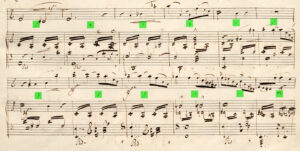
Autograph score, movement I, numbered parallel measures in the recapitulation (highlighted in green; click image to enlarge)
In Dietrich’s movement, evidence of the as-yet-incomplete recapitulation notation can be found in the parallel bar numbering concerning, on the one hand, large sections of the main theme in the exposition and recapitulation, and further parallel numbering in the region of the secondary theme and final group [see illustrations]. Furthermore, in Dietrich’s first movement and in Schumann’s finale, a comparison of the autograph score and the copied violin part reveals that the copyist must have copied certain parts of the recapitulation from the exposition (as the recapitulation in the autograph score contains small differences and errors). Of course, the copyist must have proceeded just the same way when making the score copy.
It was probably only after Joseph Joachim had left Düsseldorf that Dietrich and Schumann added the missing recapitulation sections.
DR: Why did they do that at all? There are many autograph manuscripts by Schumann, Brahms and others with omissions, numbered or otherwise marked blank bars where certain sections are to be repeated verbatim. Only then did copyists or engravers write or engrave what was not notated, in accordance with the composer’s written or oral instructions.
MS: The question is valid. Yet, the sonata was a gift: on the one hand, as a joint composition in the ideal sense, on the other, in the form of the three friends’ valuable original autograph manuscripts. Such a gift could not appear incomplete – that would have been a faux pas in terms of both gift ethics and aesthetics. Incidentally, Dietrich seems to have notated his later additions very neatly, though if you look more closely, rather cursorily. Repeatedly, slurs or dynamic markings are lacking in the recapitulation, and much is written rather imprecisely. Schumann’s recapitulation is considerably more meticulous, as can also be seen in the changes he made to the exposition in his own autograph manuscript, applicable also to the recapitulation. In the violin-part copy, these changes can actually be found in both the exposition and the recapitulation, confirming the ‘writing history’ I have reconstructed. When Schumann was adding the recapitulation to the autograph score, he now notated the altered version in fair copy.
DR: Are there any audible differences in your edition as compared to previous editions?

Violin part, copyist’s manuscript with corrections in pencil by Schumann (highlighted in yellow; click image to enlarge)
MS: Yes, in many details of the four movements, but especially in Dietrich’s opening movement and Schumann’s finale. In the latter, Schumann rewrote notes, passages and even a multi-bar accompaniment part in the copied violin part, partly in ink and partly in pencil, but did not transfer all these revisions back into his autograph. We know from Heinrich Düsterbehn’s essay that the (lost) score copy also contained intensive changes in the finale. Not to be completely ruled out are that details of the piano part in Schumann’s finale were also altered. Nevertheless, his autograph changes in the violin-part copy can, indeed must be regarded as the ‘definitive version’. I have included them in my edition’s music text – also because they do not contradict the course of the piano part in any way. The earlier readings are documented in the source and text-critical Comments. Earlier editions, on the other hand, preferred in doubtful cases to stick to the early readings of Schumann’s autograph, that is, they returned to the penultimate state of the score. Or they assessed the changes made to the violin part in the violin-part copy as ‘ossia’, thus reproducing them as equally valid variants. But this is not the case, as Schumann explicitly deleted the earlier version in the violin part and replaced it with the altered version.
DR: Your edition of the F.A.E. sonata was produced as part of the Brahms Complete Edition. Printed interestingly enough in the appendix to volume II/8, ‘Violin Sonatas’ (published in 2021), is the complete sonata, although Brahms composed only the scherzo movement. What led to the decision to include the three ‘non-Brahms’ movements in the Brahms Complete Edition?
MS: Well, in this sonata by three composers, the movements are closely related to each other – not only because they are arranged quite traditionally in the sense of a sonata-movement cycle. An important link is, of course, the f-a-e motto characterising movements 1, 2 and 4, but also the thematic link between Brahmsʼs scherzo movement and Dietrich’s first movement. These references are characteristic of the music conception of Schumann, the young Brahms and certainly also Dietrich, and to a certain extent form an intersection of their composing at that time. This all comes to the fore only when the entire work is considered – and played.
DR: Finally, a speculative question: Joseph Joachim’s friends and the Düsseldorf ‘reception committee’ also included Clara Schumann, a trained and experienced composer. Why did she not actually take part in composing the sonata? This division would have been ideal for a four-movement sonata, and, after all, Clara had just shortly beforehand composed her Three Romances for Violin and Piano op. 22, dedicated in the first edition to none other than Joseph Joachim….
MS: Your question is quite justified, Dr Rahmer. Of course, I have not discussed it in our complete edition and in my Urtext edition, because an attempt to answer it must remain too speculative. (Incidentally, I don’t even know whether the question has ever been asked and discussed in Robert and Clara Schumann research.) I am quite sure that the three composers of the F.A.E. sonata counted Clara Schumann amongst their musical friends. One speculative explanation for the fact that she was involved in playing but not in composing the sonata could be this: She had known since the beginning of October that she was pregnant again. As her letters from that time show, she felt that her health was considerably impaired. Nevertheless, she was very busy: as a concert artist, as a family manager and as a hostess for numerous visitors who came to talk and make music during October. I therefore believe it is possible that Schumann may initially have asked his wife to compose the slow 2nd movement, but that since she did not feel up to doing so, owing to her state of health and stress, he also took on this movement. Of course, there is no documentary evidence for such an assumption. Be that as it may, I would certainly not want to do without Robert Schumann’s beautiful, intimate intermezzo, very full of f-a-e sequences.
DR: Dr Struck, warmest thanks for this discussion!
